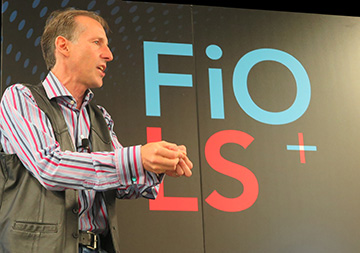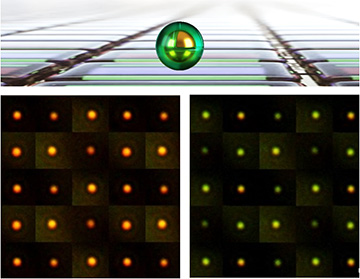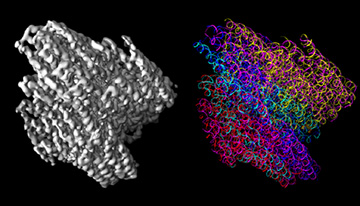
Jeremy Baumberg at FiO+LS 2019. [Image: Alessia Kirkland]
Just how “small” can light get? The disciplines of plasmonics and nanophotonics are all about the field enhancements and unusual behaviors obtained from squeezing light into tiny, subwavelength-scale spaces. In an enthusiastic and wide-ranging “Visionary Speakers” presentation at Frontiers in Optics+Laser Science 2019, a leader in the field, Jeremy Baumberg of the University of Cambridge, U.K., shared work by his team that has taken these techniques to the next level, and explored the bizarre world of light confinement at the sub-nanometer scale—an emerging area that he calls “extreme picophotonics.”
The need for maufacturability
While his team’s work focuses on the very small, Baumberg noted that much of his thinking in this area revolves around how these ideas for confining light in tiny spaces can be scaled up to something useful. “It’s nice to have this nanodevice,” he said. “But how do you make a million of the things, all identical?”
Unfortunately, conventional lithography doesn’t provide much help in that quest—at least at any reasonable cost. That fact has sent Baumberg and his team looking for alternatives.

In work published earlier this year, Baumberg’s group unveiled electrochromic nanoparticle-on-mirror constructs (eNPoMs), formed from gold nanoparticles encapsulated in a conductive polymer shell, that could serve as color-changing wraps that could save on heating and cooling energy for office buildings and other structures. [Image: NanoPhotonics Cambridge/Hyeon-Ho Jeong, Jialong Peng]
One such alternative is self-assembly. Baumberg’s team has developed a technique that uses core–shell nanoparticles and shear assembly to spin out sheets of flexible “polymer opals” with a sheen of structural color. He noted that this low-cost, roll-to-roll process can effectively produce single-domain photonic-crystal sheets kilometers in length; Cambridge has even created a company, Phomera Technologies, to commercialize it. In another application, Baumberg’s team is looking at how a similar technique might be used to make low-cost, large-area color-changing films that can be wrapped around buildings to create a climate-responsive cladding to control energy costs.
Better biosensors through smaller gaps
Notwithstanding that success in low-cost manufacturing, Baumberg admitted that the spun-out polymer-opal sheets are still hundreds of nanometers thick—well outside the realm of “extreme picophotonics.” He and his colleagues have used a number of other tricks, however, to get to those still-smaller length scales.
One is to work with metals, and leverage plasmonic field enhancement between metal nanoparticles. Putting these structures close together, he said, allows light confinement at nanometer scales. Moreover, changing the gap size changes the resonant wavelength of the confinement, pointing to some useful applications.
Once again, of course, this begs the question of just how to get the metallic nanoparticles that close together—and, again, Baumberg had some answers to share. One is to use single molecules to “glue” nanoparticles together at a controlled distance. The system potentially allows a tightly controlled gap between nanoparticles at a sub-nanometer level, which Baumberg suggested could prove useful in developing highly sensitive biosensors.
“When you trap molecules in these spaces,” he said, “you see them very clearly” by their impact on optical field enhancement. Baumberg’s team is looking at using this approach to create biomolecular sensors for “intelligent toilets” (“though I’ve been asked,” he said, “to call them ‘smart bathrooms’.”)
Graphene slabs and DNA origami
Baumberg shared some other clever approaches that his team has undertaken to get to narrower and narrower plasmonic gaps. One involves that archetypal 2-D material, graphene—monolayer sheets of carbon atoms. Baumberg’s group has developed a method for depositing one or several sheets of graphene atop a gold mirror, and planting a gold nanoparticle on top of the graphene. The team is able to tune the gap size merely by varying the number of graphene monolayers between the mirror and the nanoparticle. Baumberg called this his lab’s “workhorse” technique for robustly and repeatably creating optical cavities down to the few-nanometer regime.

DNA origami object from viral DNA visualized by electron microscopy. [Image: Origamimonkey/Wikimedia Commons; CC-BY 3.0]
Another novel approach by the group leverages a technique borrowed from biotechnology—so-called DNA origami. In this approach, lengths of heated single-stranded viral DNA are “stapled” together at specific points by smaller strands capped with specific DNA bases. As the DNA cools, the staples force the DNA strands to fold into specific shapes.
In the realm of photonics, Baumberg explained, the technique allows the placement of nanoparticles (for field enhancement) and dye molecules (for optical emission) in specific places in the DNA scaffold, effectively opening up a vast space of new possible experiments. Baumberg’s team is even looking at whether these systems can be used to create single-photon sources for quantum optics.
New windows to chemistry
Baumberg also overviewed some of the new insights that some of these techniques are making possible. In one particularly impressive example, he cited the potential for single-molecule optomechanics in picometer-scale cavities. It turns out that, even in systems in which gold nanoparticles are separated by nanometer-scale gaps, a bit of laser irradiation can nudge individual atoms out of the nanoparticle and closer to the substrate, shrinking gaps to picometer scales and light-confinement volumes to well below the size of a single atom.
The single gold atom pulled out of the nanoparticle “acts as a lightning rod,” Baumberg said, leading to extreme field concentration—and changing the readable Raman scattering spectra of the system. Baumberg notes that the system lets one reconstruct the position of molecules with precision on the order of 10 picometers.
At those length scales, he observes, one approaches the realm of single-bond, real-time chemistry. “You’re starting to watch a single bond in time,” he said, “as it fluctuates and sees its environment.”
